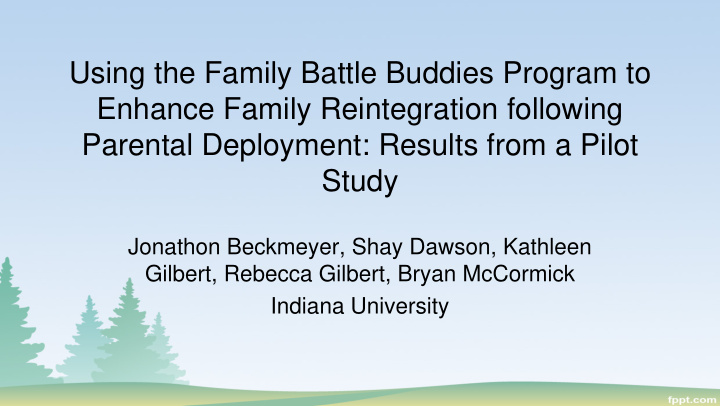



Using the Family Battle Buddies Program to Enhance Family Reintegration following Parental Deployment: Results from a Pilot Study Jonathon Beckmeyer, Shay Dawson, Kathleen Gilbert, Rebecca Gilbert, Bryan McCormick Indiana University
Team members • Presenters: – Kathleen Gilbert – Shay Dawson – Rebecca Gilbert • Additional contributors: – Jonathon Beckmeyer – Bryan McCormick
Family Battle Buddies Program • Modeled on an existing military term (Battle Buddies) which refers to a soldier looking out for one’s battle buddy during combat. • The Family Battle Buddies Program extends this commonly used military term (battle buddy) to the military family units of each soldier in the civilian environment post deployment.
Family Reintegration Expectation Reality • …family role ambiguity high • …family structure that has changed during deployment • …soldier that has changed and may have an acquired disability • …process of reintegration can take up to three years
Challenges facing reintegrating families • Reestablishment of family roles, relationships, routines, and communication • Need to adjust to normal developmental changes in family members and relationships • Changes in deployed parent, including disability
Basic principles behind FBBP • Recreational therapy approach (active, experiential learning approach) – No classroom-based instruction for family • Focus on family resiliency building – Strengths based approach • Building connections between military family members as well as enhancing individual family strengths • Challenge activities as metaphoric representations of family stressors and challenges • Leisure activities enhance family relationships through enjoyment and relaxation
Why the National Guard? • For the soldier – Return home to an “in between” status – Social connection and proximity to other soldiers is splintered upon return home • The family also sits in between • May be limited understanding of their challenges from others in their home community The National Guard has changed. • May be particularly challenging for children E.g. 48% of soldiers in the Middle East during 2004 were National Guard
Bradford Woods… … has been running programs in Recreation Therapy , Environmental Education , and Adventure Education since 1955. … sits on a 2,500-acre property with 56 buildings. … sees over 20,000 guests per year, including 1,000 children with disabilities or chronic illnesses and 6,000 fifth graders. …focusing on empirically based program development through various research projects
Our goal is to improve the quality of life for people of all abilities through transformative experiences that use our unique outdoor setting
Indiana University’s Universally Designed Outdoor Center
Universal Zip Line
Adapted Archery
Alpine Tower
Sport Pavilion
Lake and Trails
Ongoing Condition Specific Programming Research 1. A supportive environment Current research findings from BW… to grow with similar others Knapp, D., Devine, M. A., Dawson, S., & Piatt, J. (2013). Examining Perceptions of Social Acceptance and Quality of Life of Pediatric Campers with Physical Disabilities. Children's Health Care . 2. Others understand you Dawson, S., Knapp, D., & Farmer, J. (2012). “These are my war buddies”: Exploring the Therapeutic Benefits of Social Comparison at a Pediatric Oncology Camp”. Therapeutic Recreation Journal . 46 (4), 313-325. Devine, M.A., & Dawson, S.D., (2010) “The Effect of a Residential Camp Experience 3. Social Comparison Theory on Self Esteem and Social Acceptance of Youth with Craniofacial Differences.” Therapeutic Recreation Journal, 44 (2), 105-120. (Festinger, 1954) = natural human desire that can be Dawson, S. & Liddicoat, K. (2009) “Camp Gives Me Hope”: Exploring the Therapeutic Use of Community for Adults with Cerebral Palsy” Therapeutic therapeutic for those Recreation Journal, 43(4), 9-24. experiencing disability, illness, or life stressors
Program Overview • Friday – Sunday Family Retreat • Residential All Inclusive Experience (Food, Lodging, Programming) • Social Comparison with Similar Others (Family to Family, Veteran, Spouse, Child) • Strength Based Model (Build on Positives) • Experiential Therapy (Recreation Therapy and Equine Assisted Therapy) • Resiliency Building (Walsh, 2006)
Historic Manor House Fully accessible with 29 beds Individual Family Bed Rooms Pool Table Living Room / Fire Place Dining Area All families under one roof Informal leisure time together
Equine Center (Equine Assisted Learning Activities)
Art and Leisure Counseling Activities • Family Movie Poster (description of family plot, overcoming adversity, etc.) • Family Bumper Sticker (humor through adversity in the family) • Core and Balance Model of Family Functioning (Townsend – research at Bradford Woods)
Shared Recreation Activities Adolescent Specific Opportunities Family Specific Opportunities Opportunities for unstructured informal support
Grounds Initiatives & Low Ropes Purposeful interventions designed to… 1. Increase family communication 2. Build trust amongst family units 3. Reduce role ambiguity
Findings
Interviews • Open-ended questions, semi-structured – What were your experiences regarding deployment? – What were your experiences regarding the camp? • Transcribed verbatim • Themes identified
Four Main Concepts • Post-deployment adjustment • Program strengths/areas for improvement • Post-program growth • Interpretation of data
Post-deployment Adjustment • Differences in expectations – Home parent: • Single parent to dual parent • Sense of relief and resentment – Deployed parent • Soldier to civilian • Shift in primary social support from unit to spouse • Re-assumption of family role
• Reduced access to services – Distance to services provided – Frequent moving – Lack of convenience
Program Strengths • Social factors – Unstructured time was meaningful and important – Structured time with peers – Competition between families • Emphasis on teamwork within the family • Physical and mental engagement – Action-seeking – Less talking • But processing clarified understanding
• Whole family focus – Important that the entire family came along – Gave the opportunity for children to interact with other children • Removal from daily concerns
Post-program Growth • Limited data • Increased recreational engagement • Two families maintaining contact with each other • Talked about what they did
Interpretation • Weekend isolation • Family focus with family comparison • Focus on strengths over skill acquisition
Recommend
More recommend